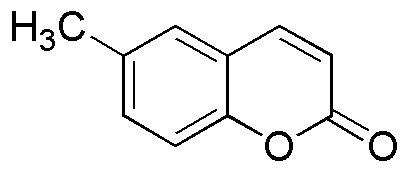6-Methylcoumarin is widely utilized in research focused on:
- Fluorescent Dyes: This compound is commonly used as a fluorescent dye in biological imaging. Its bright fluorescence allows researchers to track cellular processes in real-time, making it valuable in cell biology and medical research.
- Flavoring Agents: In the food industry, 6-Methylcoumarin serves as a flavoring agent, imparting a sweet, vanilla-like aroma to various products. This application is particularly beneficial in the production of baked goods and confectionery.
- Pharmaceuticals: The compound is also explored for its potential therapeutic properties, including anti-inflammatory and antimicrobial effects. This makes it a candidate for developing new medications.
- Cosmetics: In the cosmetics industry, it is used for its pleasant scent and is often found in perfumes and lotions, enhancing the sensory experience of personal care products.
- Research and Development: 6-Methylcoumarin is a valuable tool in synthetic organic chemistry, where it is used as a building block for creating more complex chemical structures, aiding in the development of new materials and compounds.
General Information
Properties
Safety and Regulations
Applications
6-Methylcoumarin is widely utilized in research focused on:
- Fluorescent Dyes: This compound is commonly used as a fluorescent dye in biological imaging. Its bright fluorescence allows researchers to track cellular processes in real-time, making it valuable in cell biology and medical research.
- Flavoring Agents: In the food industry, 6-Methylcoumarin serves as a flavoring agent, imparting a sweet, vanilla-like aroma to various products. This application is particularly beneficial in the production of baked goods and confectionery.
- Pharmaceuticals: The compound is also explored for its potential therapeutic properties, including anti-inflammatory and antimicrobial effects. This makes it a candidate for developing new medications.
- Cosmetics: In the cosmetics industry, it is used for its pleasant scent and is often found in perfumes and lotions, enhancing the sensory experience of personal care products.
- Research and Development: 6-Methylcoumarin is a valuable tool in synthetic organic chemistry, where it is used as a building block for creating more complex chemical structures, aiding in the development of new materials and compounds.
Documents
Safety Data Sheets (SDS)
The SDS provides comprehensive safety information on handling, storage, and disposal of the product.
Product Specification (PS)
The PS provides a comprehensive breakdown of the product’s properties, including chemical composition, physical state, purity, and storage requirements. It also details acceptable quality ranges and the product's intended applications.
Certificates of Analysis (COA)
Search for Certificates of Analysis (COA) by entering the products Lot Number. Lot and Batch Numbers can be found on a product’s label following the words ‘Lot’ or ‘Batch’.
*Catalog Number
*Lot Number
Certificates Of Origin (COO)
This COO confirms the country where the product was manufactured, and also details the materials and components used in it and whether it is derived from natural, synthetic, or other specific sources. This certificate may be required for customs, trade, and regulatory compliance.
*Catalog Number
*Lot Number
Safety Data Sheets (SDS)
The SDS provides comprehensive safety information on handling, storage, and disposal of the product.
DownloadProduct Specification (PS)
The PS provides a comprehensive breakdown of the product’s properties, including chemical composition, physical state, purity, and storage requirements. It also details acceptable quality ranges and the product's intended applications.
DownloadCertificates of Analysis (COA)
Search for Certificates of Analysis (COA) by entering the products Lot Number. Lot and Batch Numbers can be found on a product’s label following the words ‘Lot’ or ‘Batch’.
*Catalog Number
*Lot Number
Certificates Of Origin (COO)
This COO confirms the country where the product was manufactured, and also details the materials and components used in it and whether it is derived from natural, synthetic, or other specific sources. This certificate may be required for customs, trade, and regulatory compliance.

